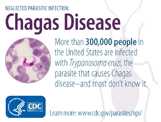Newly Diagnosed Patients
The baseline initial examination should include:
- A complete medical history, including possible exposure to the vector in endemic settings, history of blood transfusions, etc., and a review of systems (see below);
- A complete physical examination; and
- A resting 12-lead electrocardiogram (ECG) with a 30-second lead II rhythm strip.
The review of systems should focus on symptoms that can be characteristic of chronic Chagas disease, which include:
- symptoms suggestive of conduction system disease or arrhythmias, such as palpitations, syncope, presyncope, or dizziness;
- symptoms or signs of congestive heart failure, such as dyspnea, decreased exercise tolerance, and/or peripheral edema;
- symptoms compatible with thromboembolic phenomena; and
- GI symptoms, such as dysphagia, odynophagia, weight loss, prolonged constipation.
Additional examinations (such as echocardiogram, 24-hour ambulatory ECG monitoring, barium studies of the esophagus or colon) may be performed at the clinician’s discretion if indicated by the patient's symptoms or signs.
Patients should be counseled not to donate blood. If the patient has family members with a similar history of possible exposure to the parasite in endemic settings, they should be tested. Also children of infected women should be tested for the disease.
For additional information on clinical aspects of Chagas disease, contact Parasitic Diseases Public Inquiries (404-718-4745; e-mail chagas@cdc.gov).
Guidance for Evaluation and Treatment
For more detailed information on evaluation and treatment, this link provides free access to a review article:
Evaluation and Treatment of Chagas Disease in the United States: A Systematic Review (JAMA 2007: 298:2171-81)*
- Page last reviewed: October 26, 2016
- Page last updated: November 1, 2016
- Content source:



 ShareCompartir
ShareCompartir